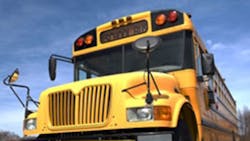All school buses should have seat belts, federal agency says
All school buses in the United States should have seat belts for every passenger, the administrator of the National Highway Traffic Safety Administration (NHTSA) says.
In a speech Sunday at a meeting of the National Association for Pupil Transportation in Richmond, Va., Mark R. Rosekind announced the change in the agency's position.
"NHTSA has not always spoken with a clear voice on the issue of seat belts on school buses," Rosekind said. "So let me clear up any ambiguity now: The position of the National Highway Traffic Safety Administration is that seat belts save lives. That is true whether in a passenger car or in a big yellow bus. And saving lives is what we are about. So NHTSA’s policy is that every child on every school bus should have a three-point seat belt. NHTSA will seek to use all the tools at our disposal to help achieve that goal."
Rosekind says his agency is launching an effort to persuade schools and bus companies across the nation to provide seat belts on their vehicles:
- The NHTSA will research ways to improve school bus safety data, specifically data about seat belts. "That includes assessment of the safety benefits in jurisdictions that currently require seat belts, and gathering data on whether seat belt requirements reduce the safety risks from driver distraction," Rosekind said.
- The agency also will work with safety advocates to determine if it can help find ways to "overcome the financial barriers to making seat belts universally available to students."
- The NHTSA will ask government and school district officials from the six states (California, Florida, Louisiana, New Jersey, New York and Texas) that already require seat belts on school buses to provide recommendations about initiating a nationwide movement for seat belts on all school buses. "Among the topics I will ask them to address is how their state and its school districts have overcome the cost hurdles that are so often cited as the reason we can’t provide seat belts to all students," Rosekind said.
"To be clear: I am not announcing a rulemaking today, nor am I prejudging the outcome of rulemaking should NHTSA begin that process," Rosekind said. "What I am saying is that NHTSA will use all the tools available in seeking to maximize safety for the nation’s schoolchildren. That means our goal is a three-point belt for every child on every bus."
In response to Rosekind's remarks, the National Association for Pupil Transportation (NAPT) said it supported the administrator's advocacy of seat belts, but said the decision should be left to local jurisdictions.
"For years, NAPT has been urging NHTSA to ... explain in clear and unambiguous language why local officials across the country should select seat belts over other available choices that might also improve school transportation safety," the association says. "Absent a federal requirement for belts, NAPT continues to agree with NHTSA that it is most appropriate if the decision to order seat belts on large school buses were left to the States and local jurisdictions. States and local school districts are better able to recognize and analyze school transportation risks particular to their areas and identify approaches to best manage and reduce those safety risks.
MORE: Video from ABC News:
About the Author
Mike Kennedy
Senior Editor
Mike Kennedy, senior editor, has written for AS&U on a wide range of educational issues since 1999.
